Plot
Elmer Triple is a chemist who is a constant source of frustration to his professor boss, who feels that while he showed promise at a young age he has ultimately never used his gifts for anything useful. Elmer aims to correct him by showing a series of concoctions he has developed. The first liquidizes an entire breakfast which can then be consumed in one gulp. Elmer's second invention can make things grow to three times their original size, which he demonstrates on a parrot and a goldfish. Elmer's final invention is a candy which he claims will make women fall in love with the first person they see. Elmer gives his candy to a young woman who turns out to be the girlfriend of a gangster. The girl falls instantly in love with Elmer and when the gangster sees the two kissing he throws Elmer back into his laboratory. He has only one of the candies left and nut it gets lost in a box of regular chocolates. He attempts to give the candy to an attractive secretary, but he himself ends up eating his specially created one and passionately kisses the secretary and subsequently receiving a beating.
The professor is unimpressed with Elmer's inventions and tells him he'd better invent something useful soon. While trying to invent noiseless fire crackers, Elmer unwittingly invents an explosive yet noiseless powder which the head of the university theorizes could be used in war zones. Elsewhere the gangster learns of the explosive powder in the paper and realizes he could use it to blow open bank vaults. The gangster and his two associates dress up as professors, convince Elmer they are there to inspect the powder and take him with them to a bank which they then hold up. When his attempts to blow up the safe, Elmer realizes he has brought his love powder instead of his explosive powder. The gang march Elmer back to the university and get him to demonstrate how the powder works. Elmer shows them that the powder explodes when brought into contact with water. Before they can make their way back to the bank, Elmer covers the gangsters in the powder and threatens to spray them with water until they turn themselves in. After taking the gangsters to the police station Elmer is hailed as a genius by numerous other professors to the university and offers them some of the growth formula he demonstrated earlier which they accept. Outside the police station Elmer is spotted by the gangster's girlfriend who is still in love with him and the two kiss. However the two are soon chased down the street by the professors who have in fact shrunken down to the size of dwarfs due to Elmer supplying them with the wrong formula.
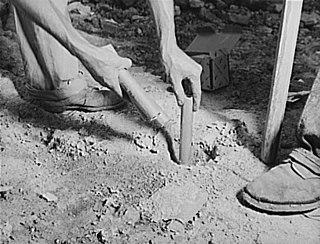
Dynamite is an explosive made of nitroglycerin, sorbents, and stabilizers. It was invented by the Swedish chemist and engineer Alfred Nobel in Geesthacht, Northern Germany, and was patented in 1867. It rapidly gained wide-scale use as a more robust alternative to the traditional black powder explosives. It allows the use of nitroglycerine's favorable explosive properties while greatly reducing its risk of accidental detonation.
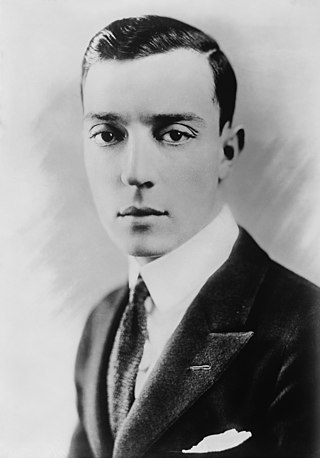
Joseph Frank "Buster" Keaton was an American actor, comedian and filmmaker. He is best known for his silent films during the 1920s, in which he performed physical comedy and inventive stunts. He frequently maintained a stoic, deadpan facial expression that became his trademark and earned him the nickname "The Great Stone Face".
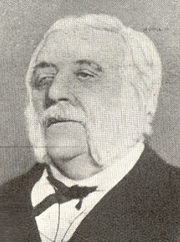
Alfred Bird was an English food manufacturer and chemist. He was born in Nympsfield, Gloucestershire, England in 1811 and was later a pupil at King Edward's School, Birmingham. He was the inventor of a series of food products, most notably egg-free custard and baking powder. His father was a lecturer in astronomy at Eton College. His son Alfred Frederick Bird continued to develop the business after his father's death.

The Goat is a 1921 American two-reel silent comedy film written, and co-directed by Malcolm St. Clair and Buster Keaton and starring Keaton.
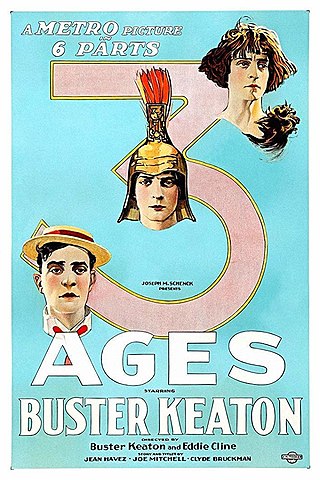
Three Ages is a 1923 black-and-white American feature-length silent comedy film starring comedian Buster Keaton and Wallace Beery. The first feature Keaton wrote, directed, produced, and starred in, Keaton structured the film like three inter-cut short films. While Keaton was a proven success in the short film medium, he had yet to prove himself as a feature-length star. It has been alleged that, had the project flopped, the film would have been broken into three short films, although this has been disputed by film historians who note that neither Keaton nor his associates made this claim in their lifetimes. The structure also worked as a parody of D. W. Griffith's 1916 film Intolerance.

The Bell Boy is a 1918 American two-reel silent comedy film directed by Roscoe "Fatty" Arbuckle for the Comique film company.

Love Nest on Wheels is a 1937 Educational Pictures short subject directed by Buster Keaton and Charles Lamont. The film borrows heavily from Keaton's 1918 film The Bell Boy.

The Hayseed is a 1919 American two-reel silent comedy film directed by and starring Roscoe "Fatty" Arbuckle and featuring Buster Keaton.
One Run Elmer is a 1935 American short comedy film featuring Buster Keaton, and directed by Charles Lamont.
Hayseed Romance is a 1935 American short comedy film featuring Buster Keaton.
Tars and Stripes is a 1935 American Educational Pictures short comedy film directed by and starring Buster Keaton. The film was shot at Naval Training Center San Diego, California.
Grand Slam Opera is a 1936 American short comedy film starring Buster Keaton and produced by Educational Pictures.
Blue Blazes is a 1936 American short comedy film directed by Raymond Kane and starring Buster Keaton.
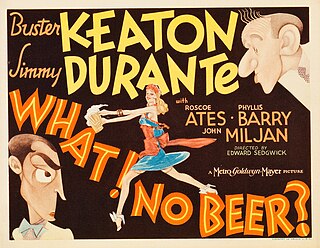
What! No Beer? is a 1933 Pre-Code comedy film released by Metro-Goldwyn-Mayer directed by Edward Sedgwick and starring Buster Keaton and Jimmy Durante. MGM had also paired Keaton and Durante as a comedy team during this period in The Passionate Plumber and Speak Easily.
MacGyver is an American television series that ran from the late 1980s to the early 1990s.
Krakatit is a 1948 Czechoslovak science fiction mystery film directed by Otakar Vávra, starring Karel Höger as a chemist who suffers from delirium and regret after inventing a powerful explosive. The film is based on Karel Čapek's novel with the same title, written in 1922. The name is derived from the volcano Krakatoa, which violently erupted in 1883.

The Buster Keaton Story is a 1957 American biographical drama film directed by Sidney Sheldon and written by Sidney Sheldon and Robert Smith, following the life of Buster Keaton. The film stars Donald O'Connor, Ann Blyth, Rhonda Fleming, Peter Lorre, Larry Keating and Jackie Coogan. It was released on April 21, 1957, by Paramount Pictures. The film was described by AllMovie as "sublimely inaccurate" regarding details of Keaton's life. It was produced by Paramount Pictures, which paid Keaton $50,000 for the rights to his life story.

Sidewalks of New York is a 1931 American comedy film directed by Zion Myers and Jules White and starring Buster Keaton. The film was commercially successful.
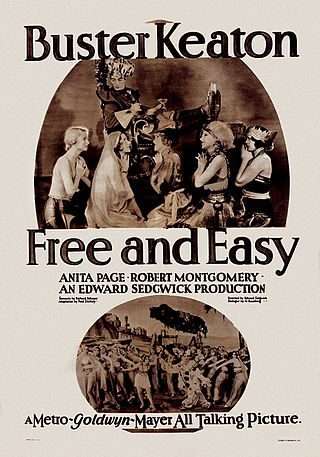
Free and Easy is a 1930 American pre-Code comedy film starring Buster Keaton. It was Keaton's first leading role in a talking motion picture.

Powder Town is a 1942 comedy about an eccentric scientist thrust into danger and romance. Max Brand worked on the screenplay and published a novelisation under his own name.
This page is based on this
Wikipedia article Text is available under the
CC BY-SA 4.0 license; additional terms may apply.
Images, videos and audio are available under their respective licenses.












